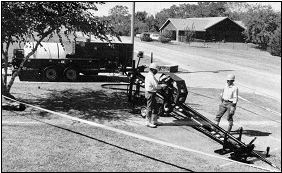 |
 |
To Print Use The pdf File
ILLINOIS URBAN MANUAL
PRACTICE STANDARD
TREE PROTECTION - AUGERING
(no.)
CODE 991
 (Source: Tree City USA Bulletin No. 35) |
DEFINITION
Underground construction such as utility work by augering (tunneling) through an individual tree's Critical Root Zone (CRZ).
PURPOSE
The purpose of this practice is to reduce damage to and loss of individual trees where underground construction involves a tree's CRZ.
CONDITIONS WHERE PRACTICE APPLIES
This practice applies on development sites containing trees, infrastructure including utilities, and a construction project that has limited space and where these elements are in direct conflict.
CRITERIA
The CRZ is one foot outside the perimeter of the leaf canopy of the tree to be protected. This area shall be protected from damage during construction operations.
All required protection measures shall be installed prior to the commencement of any site development activity and shall remain in working, functional order until all site development activities have ceased or the surrounding area has been stabilized. Protection measures, including fencing and signage, shall follow criteria in practice standard TREE PROTECTION 990.
Open trenching in the root zone of a tree is prohibited except when the trenching falls outside the CRZ.
All trees located where there is insufficient space to bypass the CRZ must be augered. Augering activity shall not occur on more than one side of the tree and shall follow distance and depth requirements in Table 1.
TABLE 1
AUGERING REQUIREMENTS
|
Tree Diameter (in.) |
Distance of Augering from Tree Trunk - each side (ft.) |
Depth of Augering (ft.) |
|---|---|---|
|
1-4 |
3 |
2 ½ |
|
5-9 |
6 |
3 |
|
15-19 |
10 |
3 ½ |
|
20 inches or more |
15 |
4 |
The following shall be avoided:
a. Making deep cuts that sever a large portion of the root system, depriving the tree of water and increasing the tree's chance of wind throw.
b. Compacting the soil within the area not designated for augering.
c. Any other actions, such as depositing concrete wash, which hardens the surface area within 25 feet of the CRZ.
CONSIDERATIONS
When working within the boundary of a municipality, local authorities such as the Urban Forester, City Arborist, Municipal Forester or Horticulturist, or Public Works officials should be contacted to determine locally enforced tree tunneling or augering requirements.
It is recommended that a professionally qualified individual check the area work plan and site for environmental soundness and evaluate the techniques for protecting the trees.
A mitigation plan for damaged trees should be prepared in consultation with a professional forester or certified arborist and included with the construction plans and contract documents.
When site soil resources have been greatly altered, it is recommended that a soil restoration strategy be implemented. The strategy may include:
1) Scarifying compacted areas
2) Adding top soil in areas of extreme erosion
3) Adding about 12 inches of well-rotted leaf compost
4) Adding ground cover using herbaceous vegetation, shrubs, & trees. Use of native species is encouraged.
PLANS AND SPECIFICATIONS
Plans and specifications for augering operations shall be in keeping with this standard and will describe the requirements for applying the practice. At a minimum include the following items:
1. The individual trees to be protected and the location of the proposed auger tunnel.
2. The location and type of fencing to be used to protect trees indicating the distance for placing the fencing around the CRZ.
3. Locations of roadways, storage areas, truck clean-out areas, and parking pads, in relationship to the trees to be protected.
4. Types and locations of signs
All plans shall include the installation, inspection and maintenance schedules with the responsible person clearly identified.
OPERATION AND MAINTENANCE
The protective signs and fences will be removed only after all construction work has been finished, including final grading and shaping of the site, and the site has been inspected by a professional forester for damages to the trees.
It is recommended that on-site inspections be conducted to determine compliance with augering specifications.
REFERENCES
Website
http://www2.champaign.isa-arbor.com/
Publications
Clark and Metheny, 1998. Trees and Development: A Technical Guide to Preservation of Trees During Land Development. International Society of Aboriculture, Champaign, IL
Watson, G. and E.B. Himelick, 1997. Principles and Practices of Planting Trees and Shrubs. International Society of Arboriculture, Champaign, IL
Videos
Root Injury and Tree Health. Illinois Arborists, Morton Arboretum, USDA Forest Service, and the International Society of Arboriculture.
Trenching and Tunneling: A Video Guide for Excavating Around Trees. Davey Resource Group, International Society of Arboriculture, and the Utility Arborist Association.
NRCS IL May 2000